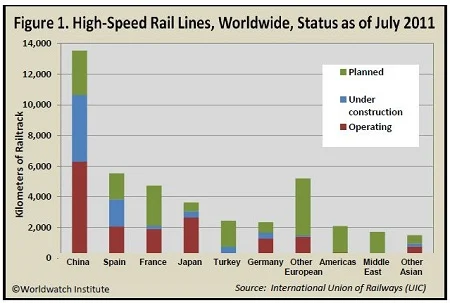High-speed rail (HSR) isn’t without its problem – as train wrecks in China and financial wrecks in California have shown.
But overall, many more fast trains are making a beeline into service around the globe, according to new research from the Worldwatch Institute for Vital Signs Online.

The study found that the number of countries with high-speed rail service was likely to double in the next few years.
“The rise in HSR has been very rapid,” Worldwatch Senior Researcher Michael Renner, who headed up the study, said in a statement.
“In just three years, between January 2008 and January 2011, the operational fleet grew from 1,737 high-speed trainsets worldwide to 2,517. Two-thirds of this fleet is found in just five countries: France, China, Japan, Germany, and Spain. By 2014, the global fleet is expected to total more than 3,700 units.”
Renner attributed high-speed rail’s growing popularity to “its reliability and ability to cover vast geographic distances in a short time,” to a desire to connect isolated regions, and to the growing feeling that traveling by airplanes in an era of hyper-security concern really sucks.
Beyond the big five, Renner said, significant expansion of high-speed rail was expected in the coming years in Turkey, Italy, Portugal and the United States.

In the study, high-speed rail’s penetration was compared by measuring the amount of track on which trains could travel 250 kilometers per hour (155 mph) for new track, and 200 kilometers per hour (124 mph) for existing, upgraded track.
By this measure, China, which is investing a staggering $100 billion annually in railway construction, is the clear leader, with 3,905 miles of track in operation and nearly 2,700 miles under construction.
Japan is second, way back at 1,652 miles of operating track, and it figures to be overtaken by Spain, where more than 1,000 miles under construction will put it over the 2,000-mile mark.
But having track and trains is only one part of the puzzle; you need passengers, as well. Japan leads there, with 47 billion passenger miles of high-speed rail travel in 2010.
Figures for China, unfortunately, were not available, but there has been concern about whether high fares for some of the new fast lines would put high-speed rail travel out of reach for many people.






